NursingLab
Welcome to nursing where we serve you with all the nursing materials that you need to get good grades. Also we offer tutoring services alongside assignment help services upon your request. Reach out to via the message panel for more discussion.
- 101
- 1
- 7
Community
- Followers
- Following
7 items
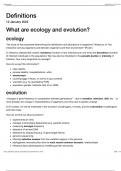
Chapter 1: Definition of Ecology and Evolution Biology
ecology “the study of the processes determining the distribution and abundance of organisms” (Krebs) or of “the interaction among organisms and between organisms and their environment” (Poulin) In infectious disease (ID) context: incidence (number of new infections per unit time) and prevalence (number of infected individuals in the population). We may also be interested in the parasite burden or intensity of infection: how many bugs/host on average? How do we get this information?...
- Package deal
- Class notes
- • 4 pages •
ecology “the study of the processes determining the distribution and abundance of organisms” (Krebs) or of “the interaction among organisms and between organisms and their environment” (Poulin) In infectious disease (ID) context: incidence (number of new infections per unit time) and prevalence (number of infected individuals in the population). We may also be interested in the parasite burden or intensity of infection: how many bugs/host on average? How do we get this information?...
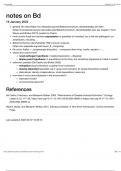
Chapter 2: Batrachochytrium dendrobatidis notes
Fungal disease has emerged as an increasing threat to a number of different organisms, especially amphibian species. Batrachochytrium dendrobatidis (Figure 1), a Chytridiomycota fungus that causes the infectious disease chytridiomycosis has been found to be the major cause of amphibian death caused by fungal infection. B. dendrobatidis infects the superficial, keratin-containing layers of amphibian skin.9 The infection then spreads across the skin, causing it to thicken and slough off. This thic...
- Package deal
- Class notes
- • 1 pages •
Fungal disease has emerged as an increasing threat to a number of different organisms, especially amphibian species. Batrachochytrium dendrobatidis (Figure 1), a Chytridiomycota fungus that causes the infectious disease chytridiomycosis has been found to be the major cause of amphibian death caused by fungal infection. B. dendrobatidis infects the superficial, keratin-containing layers of amphibian skin.9 The infection then spreads across the skin, causing it to thicken and slough off. This thic...
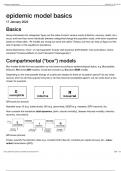
Chapter 3 epidemic model basics
Basics Group individuals into categories; figure out the rates at which various events (infection, recovery, death, etc.) occur, and how they move individuals between categories/change the population sizes; write down equations based on these rates. “All models are wrong but some are useful” (Tukey), but they can help us figure out the rate of spread, or the equilibrium prevalence. Some distinctions: micro- or macroparasite? Include vital dynamics (birth/death)? Life cycle (direct, vect...
- Package deal
- Class notes
- • 9 pages •
Basics Group individuals into categories; figure out the rates at which various events (infection, recovery, death, etc.) occur, and how they move individuals between categories/change the population sizes; write down equations based on these rates. “All models are wrong but some are useful” (Tukey), but they can help us figure out the rate of spread, or the equilibrium prevalence. Some distinctions: micro- or macroparasite? Include vital dynamics (birth/death)? Life cycle (direct, vect...
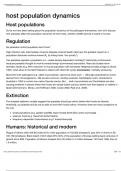
Chapter 4 host population dynamics
Host populations So far we have been talking about the population dynamics of the pathogens themselves; now we’ll discuss how parasites affect the population dynamics of their hosts, whether wildlife (animal or plant) or human. Regulation Do parasites control population size? How? High infection rate, intermediate virulence (disease-induced death rate) have the greatest impact on a population (because virulence lowers by killing hosts “too quickly”). Can parasites regulate a populat...
- Package deal
- Class notes
- • 6 pages •
Host populations So far we have been talking about the population dynamics of the pathogens themselves; now we’ll discuss how parasites affect the population dynamics of their hosts, whether wildlife (animal or plant) or human. Regulation Do parasites control population size? How? High infection rate, intermediate virulence (disease-induced death rate) have the greatest impact on a population (because virulence lowers by killing hosts “too quickly”). Can parasites regulate a populat...
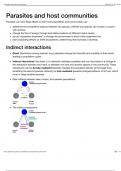
Chapter 5 Parasites and host communities
Parasites can have large effects on their host populations and communities; can determine the competitive balance between two species, whether one species can invade or coexist with another; change the flow of energy through and relative balance of different trophic levels; act as “ecosystem engineers” to change the environment in which other organisms live; have cascading effects on entire ecosystems, determining their biomass or diversity. Indirect interactions Direct interactions a...
- Package deal
- Class notes
- • 7 pages •
Parasites can have large effects on their host populations and communities; can determine the competitive balance between two species, whether one species can invade or coexist with another; change the flow of energy through and relative balance of different trophic levels; act as “ecosystem engineers” to change the environment in which other organisms live; have cascading effects on entire ecosystems, determining their biomass or diversity. Indirect interactions Direct interactions a...
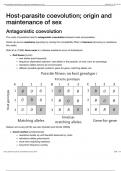
Host-parasite coevolution; origin and maintenance of sex
Antagonistic coevolution The costs of parasitism lead to antagonistic coevolution between hosts and parasites. Hosts can evolve resistance (typically by closing the compatibility filter) or tolerance (focusing on resistance this week). Stahl et al. (1999): Arms races in a disease-resistance locus of Arabidopsis Red Queen (cyclic) new alleles arise frequently frequency-dependent selection: rare alleles in the parasite, or host, have an advantage resistance alleles tend to be monomorphic ...
- Package deal
- Class notes
- • 4 pages •
Antagonistic coevolution The costs of parasitism lead to antagonistic coevolution between hosts and parasites. Hosts can evolve resistance (typically by closing the compatibility filter) or tolerance (focusing on resistance this week). Stahl et al. (1999): Arms races in a disease-resistance locus of Arabidopsis Red Queen (cyclic) new alleles arise frequently frequency-dependent selection: rare alleles in the parasite, or host, have an advantage resistance alleles tend to be monomorphic ...
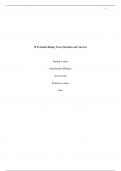
Ecology and evolution of infectious disease Questions with Answers
1. Describe and explain as many methods as you can remember for estimating R_0 from different types of data on the epidemic; explain which approaches would be the most important for different types of diseases (human vs. wildlife, epidemic vs. endemic, etc.) The basic reproduction number (R0) can be estimated through the following methods: Observing epidemic curves. In the first phase of the epidemic, the number of infections should eventually increase by the R0 factor in relation to every g...
- Package deal
- Exam (elaborations)
- • 10 pages •
1. Describe and explain as many methods as you can remember for estimating R_0 from different types of data on the epidemic; explain which approaches would be the most important for different types of diseases (human vs. wildlife, epidemic vs. endemic, etc.) The basic reproduction number (R0) can be estimated through the following methods: Observing epidemic curves. In the first phase of the epidemic, the number of infections should eventually increase by the R0 factor in relation to every g...
